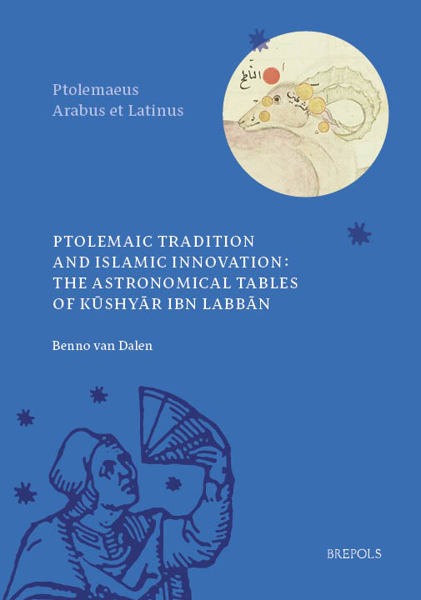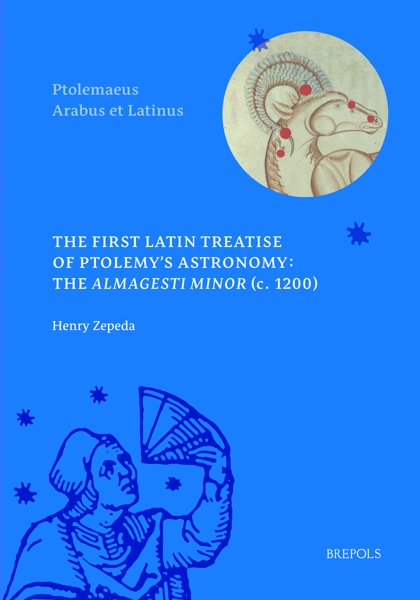
Kūshyār ibn Labbān al-Jīlī
Ptolemaic Tradition and Islamic Innovation: The Astronomical Tables of Kūshyār ibn Labbān
Benno van Dalen (ed)
- Pages: xviii + 614 p.
- Size:178 x 254 mm
- Illustrations:8 b/w, 16 col., 159 pages of tables
- Language(s):English, Arabic
- Publication Year:2022
- € 120,00 EXCL. VAT RETAIL PRICE
- ISBN: 978-2-503-59341-8
- Hardback
- Available
This book provides a critical edition of the mathematical tables in the popular Arabic astronomical handbook of the Iranian astronomer Kūshyār ibn Labbān (c. 1000).
"(...) the book succeeds in advancing the publication of Arabic astronomical tables by offering a scope that goes beyond the older editions of this type of documentation, which sometimes lacked a thorough philological discussion and were addressed only to an ultra-specialized audience. Historians and philologists of all chronological and cultural backgrounds will benefit greatly from reading van Dalen’s book." (Olivier Defaux, in Bryn Mawr Classical Review, 11/09/2022)
"To sum up, the book offers a coherent presentation and brilliant analysis of the voluminous tables in a specific astronomical handbook surviving from the medieval Middle East. The general method adopted in the study, the invaluable information imparted, and the clusters of data presented raise the book from a mere case study to the level of a complete and invaluable textbook that every scholar in the field will be required to consult for any further research into similar works from the Islamic astronomical corpus. Such comprehensive studies are not best-selling, popular works of history, but they do constitute the backbone of the history of astronomy." (S. M. Mozaffari, in Journal of the American Oriental Society, 143/4, 2023, p. 954-957) https://doi.org/10.7817/jaos.143.4.2023.r0069
“Van Dalen’s book establishes a precedent and a challenging bar to reach for future work in this field. Let us hope that others come along to join it.” (Glen Van Brummelen, in Journal for the History of Astronomy, 55/1, 2024, p. 134)
Benno van Dalen is one of the leading historians of Islamic astronomy and its transmission to China, India and Europe. He has published extensively on Arabic and Persian astronomical tables and their mathematical analysis. Van Dalen received his PhD from the University of Utrecht in 1993 and worked for more than ten years at the Institute for the History of Science in Frankfurt am Main. Since 2013 he has been one of the two research leaders of the project Ptolemaeus Arabus et Latinus at the Bayerische Akademie der Wissenschaften in Munich.
The Jāmiʿ Zīj (Comprehensive Zīj) was a highly popular Arabic astronomical handbook with tables written by the Iranian astronomer Kūshyār ibn Labbān al-Jīlī around the year 1000. It belonged to an important category of works, modelled after Ptolemy’s Almagest and Handy Tables, that allowed the practising astronomer/astrologer to carry out all necessary calculations of arcs on the celestial sphere and planetary positions, and ultimately to cast horoscopes. Around one hundred such works are extant, but only very few have been edited, translated or studied in detail.
This book contains a full treatment of Book II of Kūshyār’s astronomical handbook centred around a critical edition of all the mathematical tables and their paratexts. It sets new standards for the edition of such tables by designing new types of apparatus entries for related variants in the tabular values. The introductory part describes the eight surviving manuscripts that transmit Kūshyār’s tables and establishes by a detailed survey that they represent at least three different versions of the Jāmiʿ Zīj that in all likelihood stem from Kūshyār himself. An extensive commentary with mathematical analyses uncovers numerous new details of the methods by which the tables were computed, the astronomical parameter values on which they were based, the sources for the tables, and their influence on later zījes. These results show how Kūshyār, on the one hand, stayed firmly within the framework of the Ptolemaic tradition, but on the other introduced several types of innovations that later became common in Arabic and Persian astronomical handbooks.




